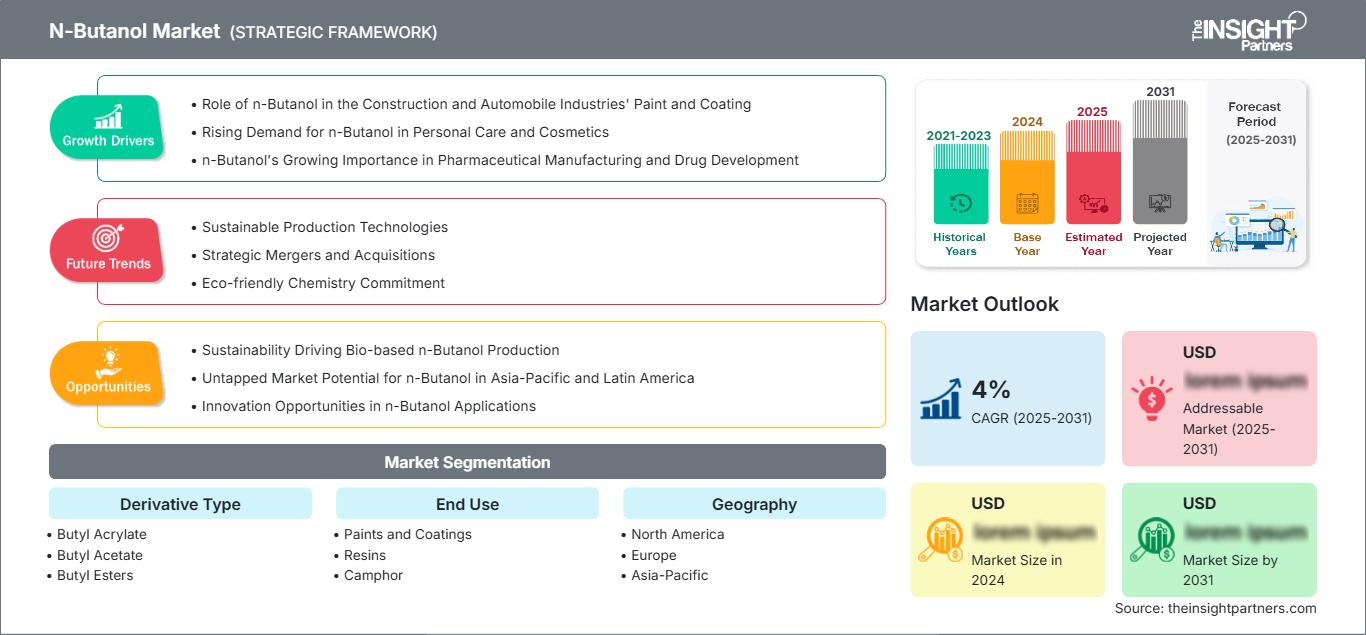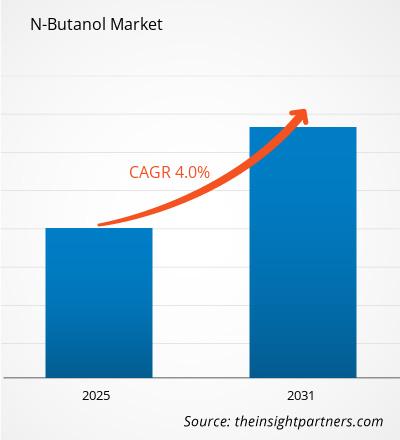Si prevede che il mercato dell'N-butanolo registrerà un CAGR del 4% dal 2025 al 2031, con una dimensione del mercato in espansione da XX milioni di dollari nel 2024 a XX milioni di dollari entro il 2031.
Il rapporto è segmentato per tipo di derivato (acrilato di butile, acetato di butile, esteri di butile e altri). Il rapporto presenta inoltre un'analisi basata sull'uso finale (vernici e rivestimenti, resine, canfora, coloranti, detergenti, aromatizzanti, biocarburanti e altri). L'analisi globale è ulteriormente suddivisa a livello regionale e per i principali paesi. Le dimensioni e le previsioni del mercato a livello globale, regionale e nazionale per tutti i principali segmenti di mercato sono trattate nell'ambito di applicazione. Il rapporto fornisce il valore in USD per l'analisi e i segmenti sopra indicati. Il rapporto fornisce statistiche chiave sullo stato del mercato dei principali attori e offre tendenze e opportunità di mercato.
Scopo del rapporto
Il rapporto "N-Butanol Market" di The Insight Partners mira a descrivere il panorama attuale e la crescita futura, i principali fattori trainanti, le sfide e le opportunità. Ciò fornirà spunti a vari stakeholder aziendali, come:
- Fornitori/Produttori di tecnologia: per comprendere le dinamiche di mercato in evoluzione e conoscere le potenziali opportunità di crescita, consentendo loro di prendere decisioni strategiche informate.
- Investitori: per condurre un'analisi completa delle tendenze in merito al tasso di crescita del mercato, alle proiezioni finanziarie di mercato e alle opportunità esistenti lungo la catena del valore.
- Enti di regolamentazione: per regolamentare le politiche e le attività di controllo sul mercato con l'obiettivo di ridurre al minimo gli abusi, preservare la fiducia degli investitori e sostenere l'integrità e la stabilità del mercato.
Segmentazione del mercato dell'N-butanolo Tipo di derivato
- Acrilato di butile
- Acetato di butile
- Esteri di butile
Uso finale
- Vernici e rivestimenti
- Resine
- Canfora
- Coloranti
- Detergenti
- Lavorante
- Biocarburante
Potrai personalizzare gratuitamente qualsiasi rapporto, comprese parti di questo rapporto, o analisi a livello di paese, pacchetto dati Excel, oltre a usufruire di grandi offerte e sconti per start-up e università
Mercato dell'N-butanolo: Approfondimenti strategici

- Ottieni le principali tendenze chiave del mercato di questo rapporto.Questo campione GRATUITO includerà l'analisi dei dati, che vanno dalle tendenze di mercato alle stime e alle previsioni.
Fattori della crescita del mercato dell'N-butanolo
- Ruolo dell'n-butanolo nelle vernici e nei rivestimenti per l'edilizia e l'industria automobilistica: la tendenza al rialzo nei settori dell'edilizia e dell'industria automobilistica, a sua volta, porta a un elevato consumo di vernici e rivestimenti, che sono anche uno dei principali utilizzatori finali dell'n-butanolo. Ciò è favorito dalla crescente urbanizzazione e dalla crescita infrastrutturale, che creano una maggiore domanda di finiture protettive e decorative. L'n-butanolo è preferito come solvente nelle vernici in quanto ne migliora le proprietà di distensione e livellamento e, in definitiva, la finitura del rivestimento. La ricerca di prodotti ecologici ha anche portato a progressi nelle formulazioni a basso contenuto di composti tossici nell'n-butanolo, che tuttavia rimane un ingrediente essenziale.
- Crescente domanda di n-butanolo nei prodotti per la cura della persona e nei cosmetici: l'industria della cura della persona e dei cosmetici ha assistito a una crescente domanda a livello mondiale di profumi, creme e formulazioni senza glutine in cui l'n-butanolo viene utilizzato come solvente e intermedio. L'espansione di questo settore è attribuita al cambiamento nei modelli di domanda dei consumatori, che si orientano maggiormente verso prodotti biologici e di alta qualità. La crescente importanza dell'igiene personale, soprattutto dopo la pandemia, ha aumentato il consumo di prodotti per la cura della persona, con un impatto positivo sul mercato dell'n-butanolo.
- Crescente importanza dell'n-butanolo nella produzione farmaceutica e nello sviluppo di farmaci: nell'applicazione farmaceutica, viene utilizzato principalmente come solvente e intermedio per la produzione di diversi farmaci. I principali fattori trainanti di questo mercato sono la crescita demografica e l'aumento dell'incidenza di malattie croniche che richiedono un maggior numero di prodotti farmaceutici. Inoltre, l'n-butanolo viene sempre più utilizzato nei processi di produzione farmaceutica a causa dello spostamento strategico verso i prodotti biofarmaceutici e dell'invenzione di nuovi farmaci.
Tendenze future del mercato dell'n-butanolo
- Tecnologie di produzione sostenibili: il mercato ha assistito ad alcuni miglioramenti nelle tecnologie di produzione dell'n-butanolo che enfatizzano la sostenibilità. Metodi come la conversione da biomassa a n-butanolo sono metodi innovativi che utilizzano materiali più ecologici, eliminando gli svantaggi associati ai metodi classici. Questi processi presentano un limite che spinge la maggior parte delle aziende a impegnarsi nella ricerca per rendere i propri processi più efficienti, poiché il desiderio di fornire più prodotti chimici ecologici è in aumento.
- Fusioni e acquisizioni strategiche: un'altra caratteristica del mercato dell'n-butanolo è il crescente numero di fusioni e acquisizioni strategiche di attori chiave che mirano a rafforzare la propria quota di mercato e diversificare le linee di prodotto. Questi processi di consolidamento consentono alle aziende di utilizzare tecnologie e sistemi di distribuzione, aumentando così la produzione e l'estensione del mercato. Ciò rientra nel piano generale per acquisire maggiori quote di mercato e rispondere alle esigenze dei clienti in un contesto in rapida evoluzione.
- Impegno per una chimica ecocompatibile: Un'altra caratteristica che caratterizza il mercato dell'n-butanolo è l'impegno verso una chimica ecocompatibile. I produttori di emulsioni sono alla ricerca di soluzioni per sviluppare solventi meno nocivi che possano essere facilmente degradati dall'ambiente, in linea con le normative e le preferenze dei clienti. In questo contesto, è in corso anche la ricerca di materie prime e processi alternativi, meno dannosi per l'ambiente ma ugualmente efficaci nel funzionamento del prodotto.
Opportunità di mercato dell'n-butanolo
- Sostenibilità alla guida della produzione di n-butanolo di origine biologica: La crescente attenzione alla sostenibilità contribuisce in modo significativo all'aumento della produzione di n-butanolo di origine biologica. I produttori possono utilizzare fonti rinnovabili per aumentare la domanda di prodotti ecologici. Tale cambiamento non solo contribuisce al rispetto delle normative, ma risponde anche alle esigenze del mercato, che privilegia i prodotti ecologici rispetto a quelli tradizionali, rendendo il business ancora più attraente.
- Potenziale di mercato inutilizzato per l'n-butanolo in Asia-Pacifico e America Latina: la maggior parte del potenziale di mercato inutilizzato per l'industria dell'n-butanolo si riscontra nelle regioni Asia-Pacifico e America Latina. Fattori come la rapida industrializzazione, l'urbanizzazione e l'aumento del reddito disponibile hanno portato a un'impennata di prodotti che incorporano nau-butanolo. Pertanto, queste aziende devono rischiare di esporre le proprie attività in quelle regioni a rischio e investire per ottenere rendimenti.
- Opportunità di innovazione nelle applicazioni dell'n-butanolo: le applicazioni dell'n-butanolo mostrano ampi margini di innovazione. Ad esempio, esiste il potenziale per lo sviluppo dell'n-butanolo per l'incorporazione in nuovi tipi di formulazioni di adesivi o sigillanti e prodotti per la pulizia. Prodotti più avanzati che potrebbero essere destinati a mercati specializzati possono anche essere sviluppati dai produttori attraverso sforzi più orientati alla ricerca e questo sviluppo può essere determinante per la crescita dei mercati dell'n-butanolo.
Approfondimenti regionali sul mercato dell'N-butanolo
Le tendenze regionali e i fattori che influenzano il mercato dell'N-butanolo durante il periodo di previsione sono stati ampiamente spiegati dagli analisti di The Insight Partners. Questa sezione analizza anche i segmenti e la geografia del mercato dell'N-butanolo in Nord America, Europa, Asia-Pacifico, Medio Oriente e Africa, America Meridionale e Centrale.
Ambito del rapporto di mercato sull'N-butanolo
| Attributo del rapporto | Dettagli |
|---|---|
| Dimensioni del mercato in 2024 | US$ XX million |
| Dimensioni del mercato per 2031 | US$ XX Million |
| CAGR globale (2025 - 2031) | 4% |
| Dati storici | 2021-2023 |
| Periodo di previsione | 2025-2031 |
| Segmenti coperti |
By Tipo di derivato
|
| Regioni e paesi coperti | Nord America
|
| Leader di mercato e profili aziendali chiave |
|
Densità degli operatori del mercato dell'N-butanolo: comprendere il suo impatto sulle dinamiche aziendali
Il mercato dell'N-butanolo è in rapida crescita, trainato dalla crescente domanda da parte degli utenti finali, dovuta a fattori quali l'evoluzione delle preferenze dei consumatori, i progressi tecnologici e una maggiore consapevolezza dei benefici del prodotto. Con l'aumento della domanda, le aziende stanno ampliando la propria offerta, innovando per soddisfare le esigenze dei consumatori e sfruttando le tendenze emergenti, alimentando ulteriormente la crescita del mercato.

- Ottieni il Mercato dell'N-butanolo Panoramica dei principali attori chiave
Punti di forza
- Copertura completa: il rapporto analizza in modo esaustivo prodotti, servizi, tipologie e utenti finali del mercato dell'N-butanolo, fornendo un panorama olistico.
- Analisi degli esperti: il rapporto è redatto sulla base della conoscenza approfondita di esperti e analisti del settore.
- Informazioni aggiornate: il rapporto garantisce la pertinenza aziendale grazie alla copertura di informazioni e dati recenti.
- Opzioni di personalizzazione: questo rapporto può essere personalizzato per soddisfare le esigenze specifiche del cliente e adattarsi in modo appropriato alle strategie aziendali.
Il rapporto di ricerca sul mercato dell'N-butanolo può quindi contribuire a guidare il percorso di decodificazione e comprensione dello scenario del settore e delle prospettive di crescita. Sebbene possano esserci alcune valide preoccupazioni, i vantaggi complessivi di questo rapporto tendono a superare gli svantaggi.
- Analisi storica (2 anni), anno base, previsione (7 anni) con CAGR
- Analisi PEST e SWOT
- Valore/volume delle dimensioni del mercato - Globale, Regionale, Nazionale
- Industria e panorama competitivo
- Set di dati Excel
Report recenti
Testimonianze
Motivo dell'acquisto
- Processo decisionale informato
- Comprensione delle dinamiche di mercato
- Analisi competitiva
- Analisi dei clienti
- Previsioni di mercato
- Mitigazione del rischio
- Pianificazione strategica
- Giustificazione degli investimenti
- Identificazione dei mercati emergenti
- Miglioramento delle strategie di marketing
- Aumento dell'efficienza operativa
- Allineamento alle tendenze normative




















 Ottieni un campione gratuito per - Mercato dell'N-butanolo
Ottieni un campione gratuito per - Mercato dell'N-butanolo